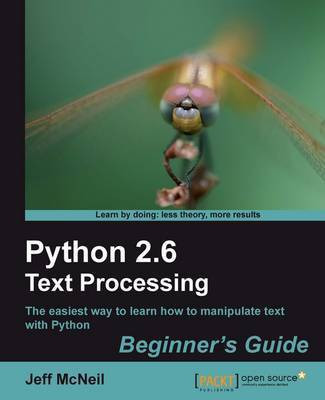Python 2.6 Text Processing: Beginners Guide(English, Electronic book text, McNeil Jeff)
Quick Overview
Product Price Comparison
The easiest way to learn how to manipulate text with Python The easiest way to learn text processing with Python Deals with the most important textual data formats you will encounter Learn to use the most popular text processing libraries available for Python Packed with examples to guide you through In Detail For programmers, working with text is not about reading their newspaper on a break; it's about taking textual data in one form and doing something to it. Extract, decrypt, parse, restructure - these are just some of the text tasks that can occupy much of a programmer's life. If this is your life, this book will make it better - a practical guide on how to do what you want with textual data in Python. Python 2.6 Text Processing Beginner's Guide is the easiest way to learn how to manipulate text with Python. Packed with examples, it will teach you text processing techniques and give you the skills to work with the most popular Python libraries for transforming text from one form to another. The book gets you going with a quick look at some data formats, and installing the supporting libraries and components so that you're ready to get started. You move on to extracting text from a collection of sources and handling it using Python's built-in string functions and regular expressions. You look into processing structured text documents such as XML and HTML, JSON, and CSV. Then you progress to generating documents and creating templates. Finally you look at ways to enhance text output via a collection of third-party packages such as Nucular, PyParsing, NLTK, and Mako. Learn text processing techniques and work with the most popular Python libraries for transforming text from one form to another What you will learn from this book Know the options available for processing text in Python Parse JSON data that is often used as a data delivery mechanism on the Internet Organize a log-processing application via modules and packages to make it more extensible Perform conditional matches via look-ahead and look-behind assertions by using basic regular expressions Process XML and HTML documents in a variety of ways based on the needs of your application Implement callback methods to perform SAX processing and walk in-memory DOM structures Understand Unicode, character encoding, internationalization, and localization Lay out a Mako template-based project by using techniques such as template inheritance, additional tags, and custom filters Install and use the Mako templating system to create your own Mako templates Process a large number of e-mail messages using the Python standard library and index them with Nucular for fast searching Fix common exceptions that occur while dealing with different types of text encoding Build simple PDF output using the ReportLab toolkit's high-level PLATYPUS framework Generate Microsoft Excel output using the xlwt module Open and edit existing Open Document files to use them as template sources Understand supporting functions and classes, such as the Python IO system and packaging components Approach This book is part of the Beginner's Guide series. Each chapter covers the steps for various tasks to process data followed by brief explanation of what is happening in each task. The explanation is followed by a few questions on the topic under discussion that will serve as a refresher course for you Who this book is written for This book is for people who have text in one format, and need it in another, as quickly as possible. You don't need any experience with text processing, but you will need some basic knowledge of Python. About the Author Jeff McNeil has been working in the Internet Services industry for over 10 years. He cut his teeth during the late 90's Internet boom and has been developing software for Unix and Unix-flavored systems ever since. Jeff has been a full-time Python developer for the better half of that time and has professional experience with a collection of other languages, including C, Java, and Perl. He takes an interest in systems administration and server automation problems. Jeff recently joined Google and has had the pleasure of working with some very talented individuals. Table of Contents Preface Chapter 1: Getting Started Chapter 2: Working with the IO System Chapter 3: Python String Services Chapter 4: Text Processing Using the Standard Library Chapter 5: Regular Expressions Chapter 6: Structured Markup Chapter 7: Creating Templates Chapter 8: Understanding Encodings and i18n Chapter 9: Advanced Output Formats Chapter 10: Advanced Parsing and Grammars Chapter 11: Searching and Indexing Appendix A: Looking for Additional Resources Appendix B: Pop Quiz Answers Index


